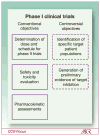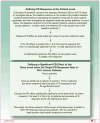Approaches to phase 1 clinical trial design focused on safety, efficiency, and selected patient populations: a report from the clinical trial design task force of the national cancer institute investigational drug steering committee
- PMID: 20215542
- PMCID: PMC5207802
- DOI: 10.1158/1078-0432.CCR-09-1961
Approaches to phase 1 clinical trial design focused on safety, efficiency, and selected patient populations: a report from the clinical trial design task force of the national cancer institute investigational drug steering committee
Abstract
The goals and objectives of phase 1 clinical trials are changing to include further evaluation of endpoints such as molecular targeted effects, in addition to dose-toxicity profile of the investigational agent. Because of these changes in focus, the National Cancer Institute and Investigational Drug Steering Committee's Task Force on Clinical Trial Design met to evaluate the most efficient ways to design and implement early clinical trials with novel therapeutics. Clinical approaches discussed included the conventional 3 + 3 cohort expansion phase 1 design, multi-institutional phase 1 studies, accelerated titration designs, continual reassessment methods, the study of specific target patient populations, and phase 0 studies. Each of these approaches uniquely contributes to some aspect of the phase 1 study, with all focused on dose and schedule determination, patient safety, and limited patient exposure to ineffective doses of investigational agent. The benefit of labor-intensive generation of preliminary biomarker evidence of target inhibition, as well as the value of molecular profiling of the study population, is considered. New drug development is expensive and the failure rate remains high. By identifying patient populations expected to respond to the study agent and tailoring the treatment with a novel drug, investigators will be one step closer to personalizing cancer treatment. The "fail early and fast" approach is acceptable if the appropriate patient population is evaluated in the phase 1 trial. The approaches outlined in this overview address the merits, advantages, disadvantages, and obstacles encountered during first in human studies.
Figures




Similar articles
-
The design of phase II clinical trials testing cancer therapeutics: consensus recommendations from the clinical trial design task force of the national cancer institute investigational drug steering committee.Clin Cancer Res. 2010 Mar 15;16(6):1764-9. doi: 10.1158/1078-0432.CCR-09-3287. Epub 2010 Mar 9. Clin Cancer Res. 2010. PMID: 20215557 Free PMC article.
-
Guidelines for the development and incorporation of biomarker studies in early clinical trials of novel agents.Clin Cancer Res. 2010 Mar 15;16(6):1745-55. doi: 10.1158/1078-0432.CCR-09-2167. Epub 2010 Mar 9. Clin Cancer Res. 2010. PMID: 20215558
-
Design of phase I combination trials: recommendations of the Clinical Trial Design Task Force of the NCI Investigational Drug Steering Committee.Clin Cancer Res. 2014 Aug 15;20(16):4210-7. doi: 10.1158/1078-0432.CCR-14-0521. Clin Cancer Res. 2014. PMID: 25125258 Free PMC article. Review.
-
The investigational drug steering committee.Clin Adv Hematol Oncol. 2007 Oct;5(10):779-80. Clin Adv Hematol Oncol. 2007. PMID: 17998895 No abstract available.
-
An overview of the optimal planning, design, and conduct of phase I studies of new therapeutics.Clin Cancer Res. 2010 Mar 15;16(6):1710-8. doi: 10.1158/1078-0432.CCR-09-1993. Epub 2010 Mar 9. Clin Cancer Res. 2010. PMID: 20215546 Review.
Cited by
-
Financial Toxicity Encountered in Therapeutic Radiopharmaceutical Clinical Development for Ovarian Cancer.Pharmaceuticals (Basel). 2020 Aug 5;13(8):181. doi: 10.3390/ph13080181. Pharmaceuticals (Basel). 2020. PMID: 32764223 Free PMC article.
-
Pragmatic approaches to address expansion cohort design.Cancer. 2018 Aug;124(16):3290-3292. doi: 10.1002/cncr.31574. Epub 2018 Jul 5. Cancer. 2018. PMID: 29975413 Free PMC article. No abstract available.
-
Phase I trials of antitumour agents: fundamental concepts.Ecancermedicalscience. 2015 Jan 19;9:501. doi: 10.3332/ecancer.2015.501. eCollection 2015. Ecancermedicalscience. 2015. PMID: 25729414 Free PMC article. Review.
-
Challenges, opportunities, and innovative statistical designs for precision oncology trials.Ann Transl Med. 2022 Sep;10(18):1038. doi: 10.21037/atm-22-356. Ann Transl Med. 2022. PMID: 36267789 Free PMC article. Review.
-
Systems pharmacology, pharmacogenetics, and clinical trial design in network medicine.Wiley Interdiscip Rev Syst Biol Med. 2012 Jul-Aug;4(4):367-83. doi: 10.1002/wsbm.1173. Epub 2012 May 11. Wiley Interdiscip Rev Syst Biol Med. 2012. PMID: 22581565 Free PMC article. Review.
References
-
- Von Hoff DD, Turner J. Response rates, duration of response, and dose response effects in phase I studies of antineoplastics. Invest New Drugs. 1991;9:115–22. - PubMed
-
- Le Tourneau C, et al. Choice of Starting Dose of Molecularly Targeted Agents Evaluated in First-in-Human Phase I Cancer Clinical Trials. J Clin Oncol. 2010 In press. - PubMed
-
- Eisenhauer EA, O’Dwyer PJ, Christian M, et al. Phase I clinical trial design in cancer drug development. J Clin Oncol. 2000;18:684–92. - PubMed
-
- Dowlati A, Manda S, Gibbons J, et al. Multi-institutional phase I trials of anticancer agents. J Clin Oncol. 2008;26:1926–31. - PubMed
-
- Parulekar WR, Eisenhauer EA. Phase I trial design for solid tumor studies of targeted, non-cytotoxic agents: theory and practice. J Natl Cancer Inst. 2004;96:990–7. - PubMed
MeSH terms
Substances
Grants and funding
LinkOut - more resources
Full Text Sources
Other Literature Sources
Medical
Miscellaneous

